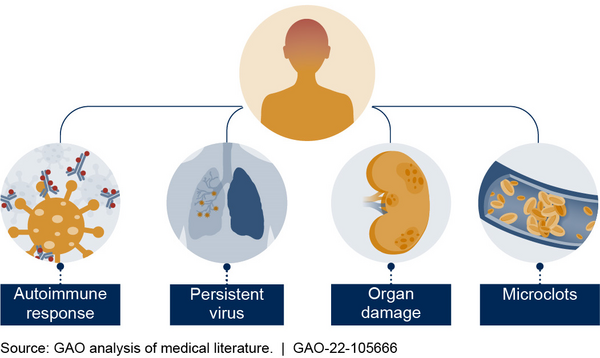Long COVID, also known as long-haul COVID, post-COVID-19 syndrome, or post-acute sequelae of COVID-19 (PASC), is a group of health problems persisting or developing after an initial COVID-19 infection. Symptoms can last weeks, months, or even years and are often debilitating. The World Health Organisation (WHO) defines long COVID as symptoms starting three months post-infection, whereas the US Centres for Disease Control and Prevention (CDC) defines it from four weeks post-infection.
Long COVID is characterised by a diverse array of symptoms, including fatigue, memory problems, shortness of breath, sleep disorders, headaches, muscle pain, and cognitive dysfunction. Symptoms may fluctuate or relapse over time and often worsen after mental or physical effort—a phenomenon known as post-exertional malaise. There is significant symptom overlap with myalgic encephalomyelitis/chronic fatigue syndrome (ME/CFS).
The exact causes of long COVID are not fully understood, but hypotheses include lasting organ damage, blood clotting issues, neurological dysfunction, persistent virus, reactivation of latent viruses, and autoimmunity. Diagnosis is based on suspected or confirmed COVID-19 infection and by excluding alternative diagnoses.

Signs and Symptoms
Long COVID symptoms impact various organs and body systems, differing significantly from person to person. Common symptoms include fatigue, muscle pain, shortness of breath, chest pain, cognitive dysfunction, and post-exertional malaise. Neurological symptoms often include difficulty concentrating, cognitive impairment, and headaches. Dysautonomia, involving palpitations and tachycardia, is also reported.

Respiratory symptoms include persistent cough and difficulty breathing, while cardiovascular issues involve chest pain and increased risk of stroke, pulmonary embolism, and myocardial infarction. Gastrointestinal symptoms may include diarrhoea and nausea. Reproductive system effects in women can involve menstrual cycle disruptions and fertility issues. Joint pain, muscle pain, hair loss, and skin rashes are also noted.
Causes and Mechanisms
The causes of long COVID may involve multiple overlapping mechanisms. Hypotheses include blood clotting issues, neurological dysfunction, immune system dysregulation, impacts on the microbiota, and autoimmunity. Persistent systemic inflammation, mitochondrial dysfunction, and the persistence of SARS-CoV-2 antigens are other potential factors.

Evidence suggests that SARS-CoV-2 may persist in the body after the acute infection, leading to symptoms. Dormant viruses, such as the Epstein–Barr virus, may reactivate. Autoimmunity is another potential cause, with some studies showing auto-antibodies in people with long COVID. Increased blood clotting and endothelial damage are also potential contributors.
Diagnosis
There are no standardised tests to diagnose long COVID. Diagnosis relies on a history of suspected or confirmed COVID-19 and the exclusion of alternative diagnoses. Diagnostic criteria have evolved to no longer require laboratory-confirmed COVID-19 infection due to the potential for asymptomatic infections.
Diagnostic tools for specific symptoms, such as tilt table tests for POTS or MRI scans for cardiovascular issues, are available. However, routine tests often come back normal for long COVID patients.
Prevention
Preventing COVID-19 infection remains the most effective way to prevent long COVID, through measures such as improving ventilation, avoiding contact with infected individuals, hand hygiene, and wearing N95 masks. COVID-19 vaccination reduces the risk of long COVID, though the extent of its effectiveness varies.
Clinical Care

As of 2023, there are no established treatments for long COVID. Management depends on the symptoms, with rest and pacing advised for fatigue and post-exertional malaise. Specialised long COVID clinics have been established in some countries for comprehensive care.
Prognosis
Around two-thirds of people with symptoms at four weeks recover fully by twelve weeks. Prognosis varies by individual and symptom type, with some people experiencing symptom worsening within three months. Neurological symptoms may have a delayed onset and some may worsen over time. Symptoms like muscle and joint pain can persist or worsen after one year. For those meeting ME/CFS criteria, symptoms are likely to be lifelong.

Self-assessment MCQs (single best answer)
What is another term for Long COVID?
Which organisation defines long COVID as symptoms starting three months post-infection?
What is a common characteristic of long COVID symptoms?
Which of the following is NOT a symptom commonly associated with long COVID?
What is one hypothesis for the cause of long COVID?
Which diagnostic tool might be used for specific symptoms of long COVID, such as POTS?
What is the most effective way to prevent long COVID?
As of 2023, what is the established treatment for long COVID?
Which demographic is somewhat more likely to get long COVID in the United States?
What condition has significant symptom overlap with long COVID?
Dentaljuce
Dentaljuce provides Enhanced Continuing Professional Development (CPD) with GDC-approved Certificates for dental professionals worldwide.
Founded in 2009 by the award-winning Masters team from the School of Dentistry at the University of Birmingham, Dentaljuce has established itself as the leading platform for online CPD.
With over 100 high-quality online courses available for a single annual membership fee, Dentaljuce offers comprehensive e-learning designed for busy dental professionals.
The courses cover a complete range of topics, from clinical skills to patient communication, and are suitable for dentists, nurses, hygienists, therapists, students, and practice managers.
Dentaljuce features Dr. Aiden, a dentally trained AI-powered personal tutor available 24/7 to assist with queries and provide guidance through complex topics, enhancing the learning experience.
Check out our range of courses, or sign up now!


